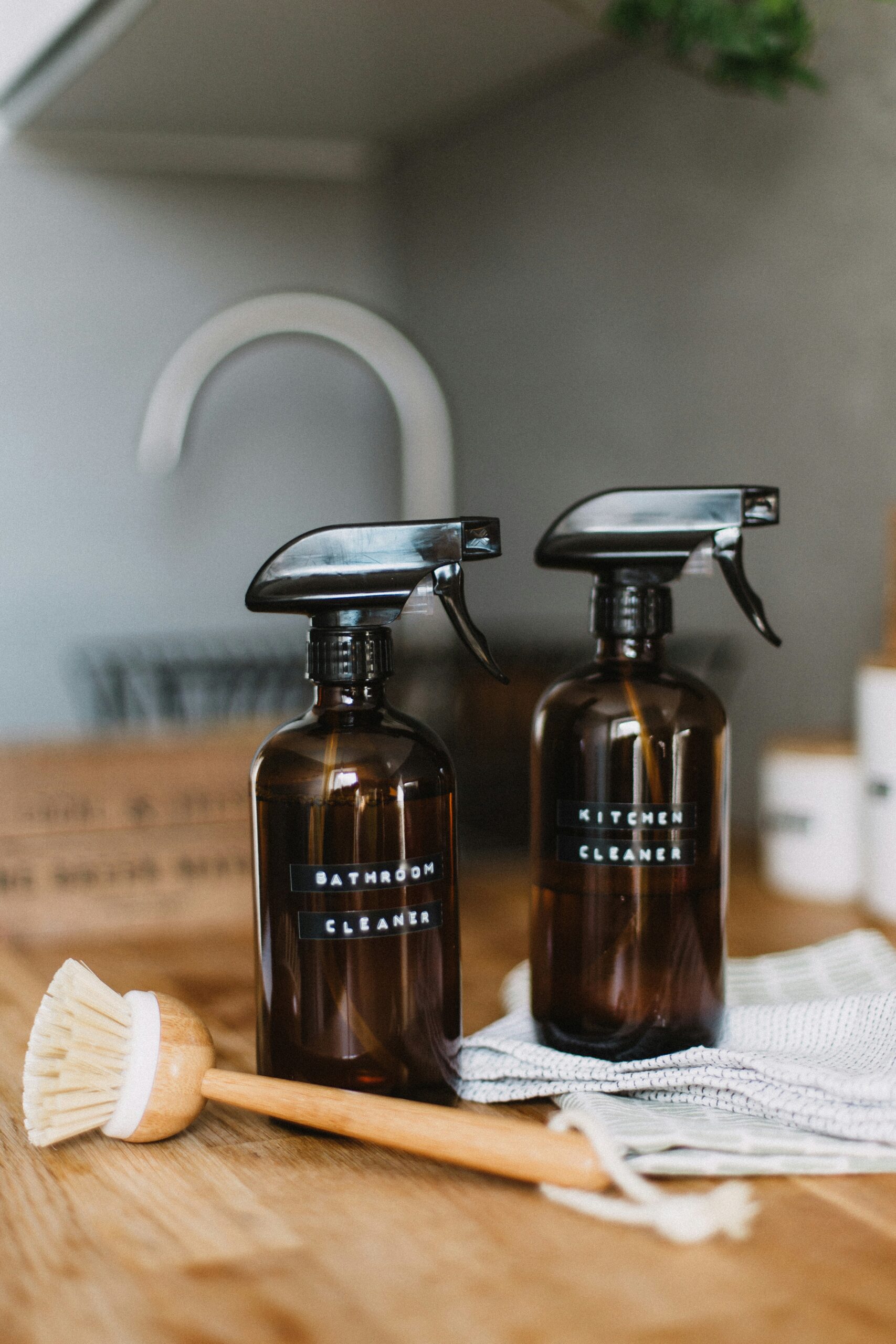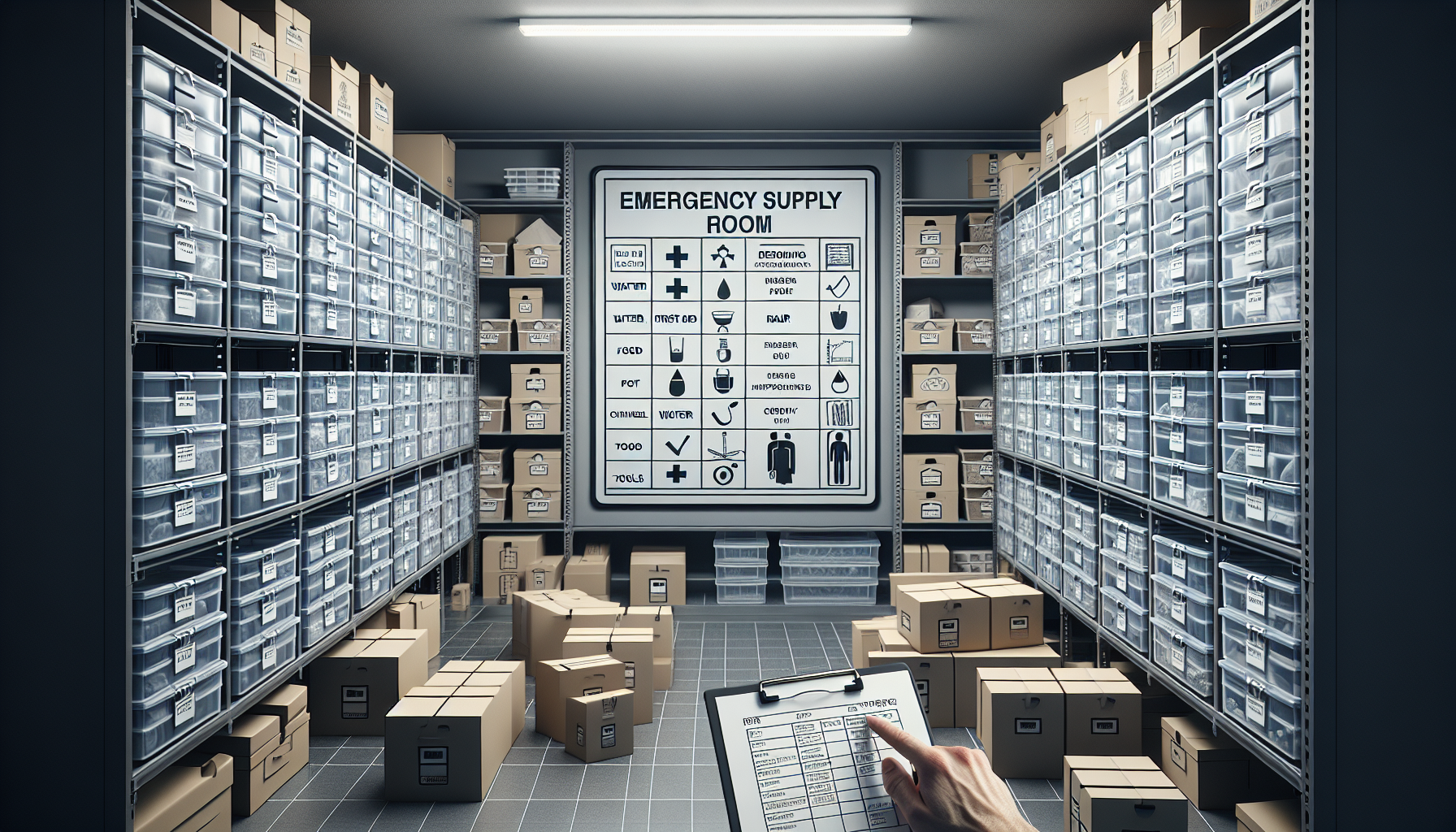When it comes to storing emergency supplies, it’s crucial to be prepared for any unexpected situation that might come your way. From natural disasters to power outages, having the right storage methods in place can make all the difference. In this article, we will explore some of the best ways to store emergency supplies, ensuring they remain accessible, organized, and ready for use when you need them most. So, whether it’s food, water, medical supplies, or other essentials, let’s dive into the world of emergency preparedness and discover the most effective storage techniques for your peace of mind.

Choosing the Right Location
Considerations for location
When it comes to storing emergency supplies, choosing the right location is essential. You want a spot that is easily accessible but also secure. Consider a location that is easily reachable in case of an emergency, such as a basement or a designated storage area. However, it’s essential to ensure that the location is secure to prevent theft or damage. Choose a spot that is not easily visible from the outside and has proper locking mechanisms in place.
Accessible but secure spots
Finding a balance between accessibility and security is crucial when selecting a location to store your emergency supplies. While you want the supplies to be within reach in case of an emergency, you also want to protect them from potential thieves or prying eyes. Consider installing secure storage solutions, such as locked cabinets or safes. You might also want to choose a spot that is not easily accessible to children or pets to ensure the safety of both.
Protected from extreme weather conditions
Another vital factor to consider when choosing a location for your emergency supplies is protecting them from extreme weather conditions. Extreme heat or cold can damage certain items, rendering them useless when you need them the most. Look for a spot that is insulated and shielded from extreme temperatures. Avoid storing supplies in areas prone to flooding or excessive moisture, as this can lead to mold or water damage. A dry, temperature-controlled area is ideal for preserving the integrity of your emergency supplies.
Containers and Packaging
Use of airtight containers
Once you have chosen the appropriate location, it’s essential to invest in high-quality containers and packaging for your emergency supplies. Airtight containers are a must-have to keep your items safe from moisture, pests, and air exposure. Consider using plastic bins with gasket seals or mylar bags with oxygen absorbers for long-term storage. These airtight containers will help extend the shelf life of your supplies and ensure they are ready for use when an emergency occurs.
Waterproof packaging
To further protect your emergency supplies, it is crucial to invest in waterproof packaging. This is particularly important if you live in an area prone to flooding or heavy rainfall. Even in less extreme scenarios, such as a leaking pipe or roof, waterproof packaging can save your supplies from water damage. Look for packaging options specifically designed to resist water penetration and consider using waterproof labels or markers to ensure the contents stay identifiable.
Durable and stackable boxes
In addition to airtight and waterproof containers, it’s also important to opt for durable and stackable boxes when storing your emergency supplies. These boxes will not only protect your supplies from accidental damage but also help maximize the available storage space. Look for containers made of sturdy materials, such as hard plastic or metal, that can withstand stacking and potential impacts. This will make it easier to organize your supplies and ensure they are accessible when needed.
Organizing and Categorizing
Create a system of organization
An organized storage system is essential for efficient access and maintenance of your emergency supplies. Create a systematic approach to organizing your supplies, considering factors such as frequency of use and item categories. For example, you may want to keep frequently used items in easily accessible areas, while less frequently used supplies can be stored in less accessible spots. Establishing clear guidelines on where each item should be stored will help you quickly locate what you need during an emergency.
Categorize emergency supplies
Categorizing your emergency supplies can further enhance the organization of your storage area. Create categories based on the type of emergency, such as medical supplies, food and water, tools and equipment, and personal hygiene items. Within each category, consider subcategories to further streamline the organization. For example, within the food and water category, you could have sections for canned goods, long-lasting food options, and water purification supplies. By categorizing your supplies, you can easily locate specific items when needed.
Labeling and inventory
Labeling your storage containers and maintaining an inventory is a crucial step in keeping your emergency supplies organized. Use clear and descriptive labels to identify the contents of each container. This will save you time during emergencies and prevent the need to open multiple containers to find what you need. Additionally, periodically update your inventory to ensure you know what supplies you have on hand and when items need replenishing. Maintaining accurate records of your emergency supplies will help you stay prepared and avoid any last-minute scrambling during a crisis.
Storing Food and Water
Preserving long-lasting food options
When it comes to storing food for emergencies, it’s important to choose long-lasting options that can sustain you and your family for an extended period. Consider stocking up on canned goods, freeze-dried or dehydrated meals, and non-perishable food items with a long shelf life. Be mindful of any dietary restrictions or allergies within your household and select food options accordingly. Regularly rotate and consume the stored food to ensure freshness and check expiration dates to avoid consuming expired items.
Stocking water supplies
Water is a critical resource in any emergency situation, so it’s crucial to stock an ample supply. The general guideline is to store one gallon of water per person, per day, for at least three days. However, consider your specific needs, including any medical requirements or the presence of infants, and adjust accordingly. Store water in sturdy, clean containers that are specifically designed for long-term water storage. Keep the containers in a cool, dark place to prevent bacterial growth or degradation of the containers over time.
Rotating and monitoring expiration dates
When storing food and water supplies, it’s essential to regularly rotate and monitor expiration dates. Check your inventory periodically and consume or donate items that are approaching their expiration dates. This practice ensures that you always have fresh supplies accessible and minimizes waste. Develop a system to track expiration dates, such as labeling containers with the purchase or expiration date. By staying attentive to expiration dates, you can maintain a consistent supply of safe and reliable emergency food and water.

Maintaining Emergency Kits
Regularly check and update supplies
Maintaining your emergency kits requires regular checks and updates to ensure they remain fully equipped. Set a schedule to review your kits at least twice a year, checking for expired items, damaged packaging, or missing supplies. Replace any items that have expired or show signs of deterioration. Use this opportunity to restock any depleted items and ensure your emergency kits are ready for any situation that may arise.
Replacing expired items
Expired items can pose a risk to your safety and diminish the effectiveness of your emergency kits. When conducting your regular checks, be diligent in identifying and replacing expired items promptly. Consider marking the expiration dates on items with a visible marker or label during the initial storage process. This will make it easier to identify and remove expired items during future inspections. By keeping your emergency kits stocked with fresh supplies, you can have peace of mind knowing they are reliable during times of need.
Rotating seasonal supplies
Seasonal supplies, such as warm clothing, blankets, or insect repellent, should be rotated based on the changing seasons. In colder months, ensure your emergency kits are equipped with appropriate winter gear and heating resources. As the weather warms, transition to lightweight clothing, sun protection, and bug repellent. Adjusting and rotating your seasonal supplies will help ensure your emergency kits are tailored to the specific needs of each season and can provide comfort and protection in any weather conditions.
Considerations for Medications
Proper storage of prescription medications
If you or a family member relies on prescription medications, it’s essential to store them properly in your emergency supplies. Follow the medication’s specific storage instructions, which are typically provided on the packaging or by your healthcare provider. Factors such as temperature and exposure to light or moisture can affect the stability and efficacy of medications. Consider using a portable, insulated medication cooler for emergency storage, ensuring that the required temperature range is maintained.
First aid kit essentials
A comprehensive first aid kit is an essential component of any emergency supplies. Ensure your first aid kit is properly stocked with essentials such as bandages, gauze pads, adhesive tape, disinfectants, and over-the-counter medications for common ailments. Regularly check the expiration dates on all items and replace them as needed. Additionally, consider including a manual or guidebook that provides instructions for basic first aid procedures. Familiarize yourself with the contents of your first aid kit and educate other members of your household on how to use them effectively.
Preventing heat and moisture damage
Heat and moisture can damage medications and first aid supplies, rendering them ineffective in emergencies. Be mindful of the storage conditions for these items, avoiding areas that are prone to temperature extremes or excessive moisture. Keep medications and first aid supplies away from direct sunlight or direct contact with heavy condensation. Consider using moisture-absorbing packets or containers to further protect sensitive items. By preventing heat and moisture damage, you can ensure that your medications and first aid supplies remain safe and effective when needed.

Managing Power Sources
Backup power options
Having reliable power sources during emergencies is crucial to maintain communication, lighting, and power essential devices. Consider investing in backup power options such as portable generators or battery-powered inverters. These backup power sources can supply electricity to charge cell phones, power emergency lighting, or operate necessary medical devices. Ensure that backup power sources are properly maintained, stored in accessible locations, and equipped with the necessary fuel or batteries to operate for an extended duration.
Storing batteries and chargers
To ensure your backup power sources are ready to use when needed, it’s crucial to store an ample supply of batteries and chargers. Keep a variety of battery sizes on hand to fit various devices, such as flashlights, radios, and portable fans. Store batteries in a cool, dry place, separate from the devices they power, to prevent drain or leakage. Similarly, keep chargers for rechargeable devices readily accessible and organized. Regularly check and replace batteries to maintain a consistent power supply in your emergency kits.
Solar-powered devices
Incorporating solar-powered devices into your emergency supplies can offer environmentally-friendly and long-term power solutions. Solar-powered chargers, flashlights, radios, and lanterns can harness energy from the sun to recharge and operate without relying on battery power. These devices are particularly useful during extended power outages or situations where traditional power sources are limited. When storing solar-powered devices, ensure they have access to direct sunlight for recharging and periodically test their functionality to guarantee they are in optimal working condition.
Protecting Important Documents
Secure document containers
Protecting important documents is essential in emergency preparedness. Invest in secure document containers, such as fire-resistant safes or lockable filing cabinets, to safeguard valuable papers. These containers are designed to protect documents from fire, water damage, and theft. Organize your documents within the containers, categorizing them by importance and relevance. Having a secure location for critical documents ensures quick and easy access during emergencies while providing peace of mind that your important information is protected.
Make copies of important documents
Creating copies of your important documents is a crucial step in emergency preparedness. Make photocopies or scan and digitally backup essential documents such as identification cards, passports, insurance policies, and financial records. Store the copies in a separate, secure location from the originals. Additionally, consider sharing electronic copies with trusted family members or keeping them in cloud storage for easy access from any location. Having duplicates of important documents provides a safety net in case the originals are lost, damaged, or inaccessible during an emergency.
Digital storage options
In addition to physical document protection, digital storage offers an extra layer of security for important information. Scan and save important documents in secure digital formats, such as PDF, on external hard drives or cloud storage platforms. Be sure to encrypt the digital files and store them in password-protected folders. Regularly back up the digital files to prevent data loss and ensure you have the latest versions of your documents. Digital storage provides a convenient and easily accessible option for retrieving important information during emergencies.

Creating Emergency Kits for Different Scenarios
Tailoring kits to specific emergencies
Preparing for different emergency scenarios requires tailoring your emergency kits to individual needs. Assess potential risks in your area, such as hurricanes, earthquakes, power outages, or civil unrest, and consider the specific supplies and equipment required for each situation. For example, a hurricane kit may include items such as tarps, hurricane shutters, or sandbags, while an earthquake kit may prioritize sturdy footwear, dust masks, or a pry bar. Take into account the unique challenges presented by each emergency and ensure your kits are adequately equipped to address them.
Considerations for home and travel kits
Emergency preparedness extends beyond your home. Consider creating separate emergency kits for your vehicle and workplace to ensure you are prepared in any environment. Car kits should include basic tools, jumper cables, a flashlight, blankets, and non-perishable snacks. Workplace kits may include a small first aid kit, bottled water, and personal essentials such as medications or spare glasses. Tailor these kits to the unique challenges and resources available in each setting to promote safety and provide peace of mind.
Pet and baby necessities
If you have pets or young children, it’s crucial to include their specific necessities in your emergency kits. Pets require food, water, medications, leashes, and comfort items. Pack a separate bag for your pet that includes these essentials, along with vaccination records and identification tags. For infants and young children, include formula, diapers, wipes, extra clothing, and any necessary medications. Consider the unique needs of your pets and children and ensure they are accounted for in your emergency preparedness plans.
Reviewing and Updating Emergency Plans
Regularly evaluate and update emergency plans
Emergency preparedness is an ongoing process that requires continuous evaluation and updating of your plans. Regularly review your emergency plans, considering changes in family dynamics, location, or potential risks. Include all household members in these discussions and ensure everyone is familiar with the emergency procedures and the location of emergency supplies. Reviewing and updating your plans will help ensure that they remain relevant and effective in keeping you and your loved ones safe during emergencies.
Practice drills and simulations
In addition to reviewing plans, it’s crucial to practice drills and simulations to prepare for emergency situations. Conduct fire drills, evacuation drills, or other relevant exercises to familiarize household members with the appropriate actions to take in different scenarios. Practice assembling and using emergency supplies, such as first aid kits or emergency radios. These drills and simulations will help build confidence, improve response times, and identify any gaps or areas for improvement in your emergency preparedness plans.
Keep emergency contacts updated
Maintaining an up-to-date list of emergency contacts is essential for effective communication during emergencies. Ensure that all household members have a copy of these contact details, including phone numbers of family members, neighbors, emergency services, and medical professionals. Regularly review and update this list, particularly if there are changes in contact information or new individuals who should be added. In addition to a printed list, consider storing these contact details digitally on a smartphone or other portable devices for easy access. Being able to quickly reach out to the appropriate individuals during an emergency can make a significant difference in the outcome.


